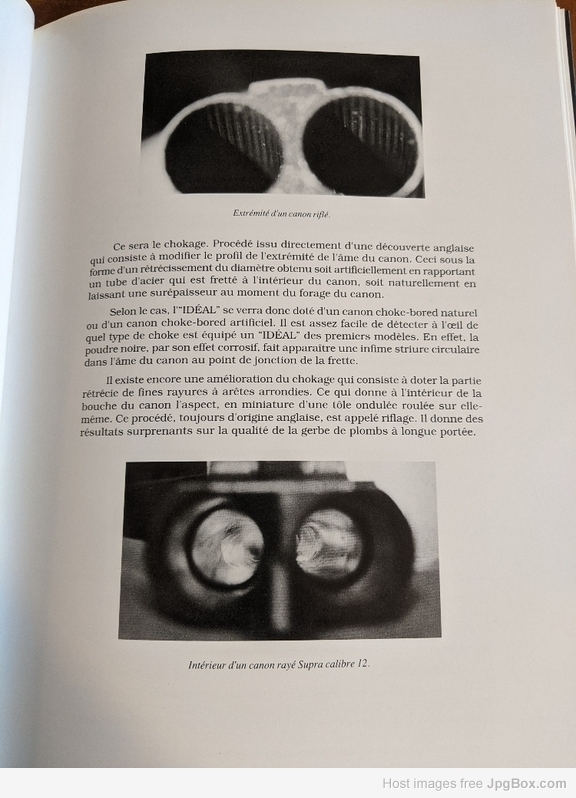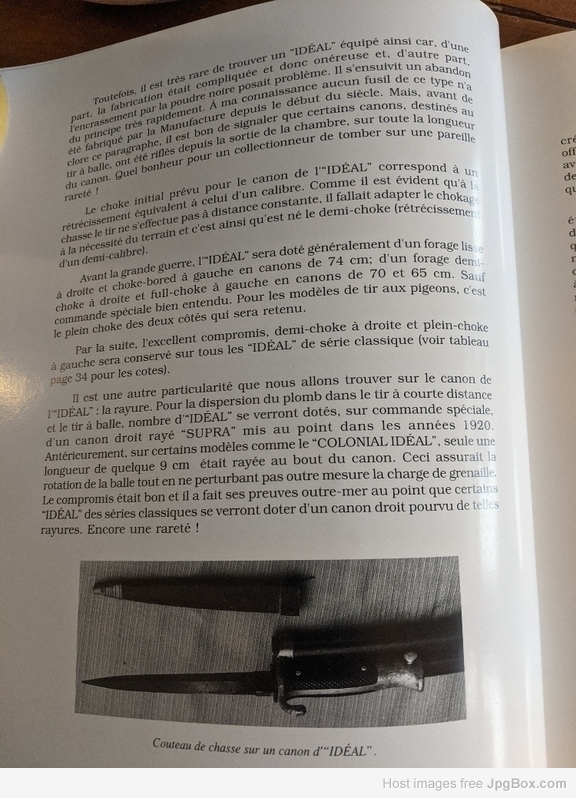
Sidelock
Joined: Feb 2016
Posts: 3,602 Likes: 504 |
Might as well repost this. Last February Gil asked me to take a look at this article on "Raye" barrels - see last paragraph.   Here was my response: Gil, about the best I can do for the moment. I thought I had all the French gun terms down...fat chance. I could not get the impression that a barrel insert could be put into a smooth bore from this article. My impression is the two pages dealt with:
1) traditional Greener type choke boring
2) artificial choke boring by casting a rifled ring at the muzzle of the gun
3) rifling the length of the choke which seemed to increase the range of the shot but gave problems with fouling using black powder.
4) rifling the full length of a bore, meant for shooting shot and ball
5) rifling about 8 cm of the part of an unchoked bore directly in front of the chamber which allowed a ball to rotate but allowed normal "spreader" use of 4-9 shot.
Wildcattle probably could give a better translation but I think this is the gist:That will be the chokes. These came directly from a English discovery which consisted of modifying the profile of the end of the bore of the barrel. These were a form of constricting the diameter of the bore achieved artificially by laying a (small) tube of rifled steel in the interior of the barrel (at the muzzle) naturally leaving a supression at the moment of the casting of the barrel
In the case of l’IDEAL, is was thus developed barrels naturally choke-bored and those artifically choke-bored. It is quite easy to detect with the eye which type of choke an IDEAL is equiped with in the first models. In effect the black powder, by its corrosiveness, left a tiny circular streak in the bore of the barrel at the point of the junction with the monobloc.
There exists yet another combination of choke systems which consists of putting fine stripes on the tapering of the choke on the rounded edges. This gives to the interior of the mouth of the barrel the aspect in miniature of a crinkled tapered tube. This process, also of English origin, is called rifling. It gives surprising results in the the long range of the pellets.
Nevertheless, it is very rare to find an IDEAL so equipped because on one part the fabrication was complicated and thus onerous and, on the other part, the fouling by black powder posed a problem. This led them rapidly to abandon the concept. To my knowledge no long gun of this type has been made by the Manufacturer since the beginning of the century. But, before closing this paragraph, it’s worth noting that certain barrels, meant for firing ball, were rifled from the exit of the chamber, along the entire length of the barrel. What happiness for a collecter to come upon such a rarity.
The choke initially seen on the barrel of the IDEAL corresponded to a constriction equivalent to that of one caliber. As it is evident that shooting during a hunt doesn’t take place at a constant distance, it was necessary to adapt the chokes according to the ground and thus also was born the half-choke (constriction by a half caliber)
Before the great war, the IDEAL generally carried an open smoothbore barrel on the right and a choke-bored one on the left for barrels 74 cm in length. Bores with half choke on right and full choke on the left on barrels from 65-70 cm. Except for special orders of course. For pigeon shooting models, full choke on both sides was the norm.
Thereafter, that excelent compromise, half-choke on the right and full-choke on the left were kept on all the classic series IDEALs. (see the tables on page 34).
There is another particularity which we are going to find on the barrels of the IDEAL. The (shallow) rifling. For the dispersion of shot when firing at a short distance and for the shooting of ball, a number of IDEAL came, on special order, with the right barrel (unchoked) rifled “SUPRA” beginning in the 1920’s. Previously, on certain models such as the COLONIAL IDEAL, only one length of some 8 cm was striated (rifled) at the beginning of the barrel. This assured the rotation of the ball without perturbing in the slightest the smaller shot. The compromise was a good one and it made its mark abroad to the point that certain of the classic series can be seen with the right barrel provided with such rifling. Such a rarity.
Last edited by Argo44; 12/19/20 03:06 PM.
Baluch are not Brahui, Brahui are Baluch
|